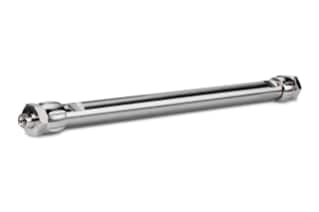
|
Chemistry |
C18 |
|
Separation Mode |
Reversed Phase |
|
Particle Substrate |
Hybrid |
|
pH Range Min |
1 pH |
|
pH Range Max |
12 pH |
|
Maximum Pressure |
6000 psi (415 Bar) |
|
Endcapped |
Yes |
|
Silanol Activity |
Low |
|
Molecular Weight Range Min |
1000 |
|
Molecular Weight Range Max |
15000 |
|
Particle Shape |
Spherical |
|
Particle Size |
10 µm |
|
Endfitting Type |
Waters |
|
Pore Size |
300 Å |
|
QC Tested |
Peptide |
|
Format |
OBD Prep Column |
|
Surface Area |
90 |
|
System |
HPLC |
|
Particle Technology |
BEH |
|
USP Classification |
L1 |
|
Inner Diameter |
10 mm |
|
Length |
250 mm |
|
Carbon Load |
12 % |
|
UNSPSC |
41115709 |
|
Application |
Peptide |
|
Brand |
XBridge |
|
Product Type |
Preparative Columns |
|
Units per Package |
1 pk |

XBridge Peptide BEH C18 OBD Prep Column, 300Å, 10 µm, 10 mm X 250 mm, 1K - 15K, 1/pk
Columns fail in two ways: physically and chemically. The most common reason for column life reduction when using low-pH mobile phases is the hydrolysis of the bonded phase, which manifests as major variations in peptide retention. The Waters BEH Technology Column features patented bonding and end-capping techniques that produce stable bonded phases. The BEH C18 Columns demonstrated negligible retention loss in low-pH stability tests. The physical stability of these columns is ensured by Waters' proprietary Optimum Bed Density (OBD) Technology, which was developed to generate packed beds that are the most stable of any available, independent of manufacturer.
For peptide separations, the XBridge BEH300 C18 Peptide Separation Technology (PST) columns have been optimized and QC verified. To assess samples for proteomics, protein characterization, and peptide synthesis, you can rely on the wide-pore (300) tri-functionally bonded BEH particle to provide you with the widest useable pH range, improved low pH stability, and ultra-low column bleed.
You can find all of Waters' product options, including analytical columns, guard columns, vials, and other equipment, by perusing our brochure or visiting our website, where you can shop for lab equipment and contact us with any questions.
You may also want to check out AutoPurification System Standard; The range of standards and mixes that makes up the Quality Control Reference Material is special. These tools enable the user to analyze and benchmark their chromatography equipment prior to performing essential material analysis. The portfolio's goods have all been uniquely created based on the knowledge of Waters experts. Thionin, Thioflavin, and Crystal Violet are among the three components in the AutoPurification Dye Standard. Through fraction collection, this standard mix is utilized to confirm the benchmark performance of a Preparative/Purification System. This QCRM has been specially designed to allow the user to verify proper fraction collection. This test is extremely valuable to run upon first use/installation, as well as whenever the system has not been utilized or has undergone any changes.
How Does BEH Technology Function?
The BEH (Ethylene Bridged Hybrid) particle, which comes in a variety of pore diameters and bonded phases, is a key enabler of UPLC technology, allowing both reversed-phase and hydrophilic contact chromatography. The method can be used for a variety of bio-pharmaceutical analyses, from small molecules to large molecules. Because of the intrinsic chemical stability of hybrid particle technology, a wider pH range [pH 1-12] is acceptable. This also enables the creation of a versatile strong separation technology. BEH particle technology is available in four HPLC particle sizes [2.5, 3.5, 5, and 10 µm], allowing for a seamless transition between HPLC and UPLC technology platforms.